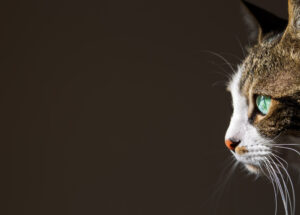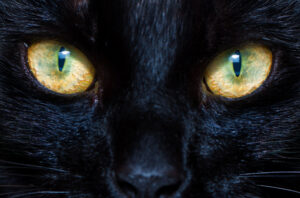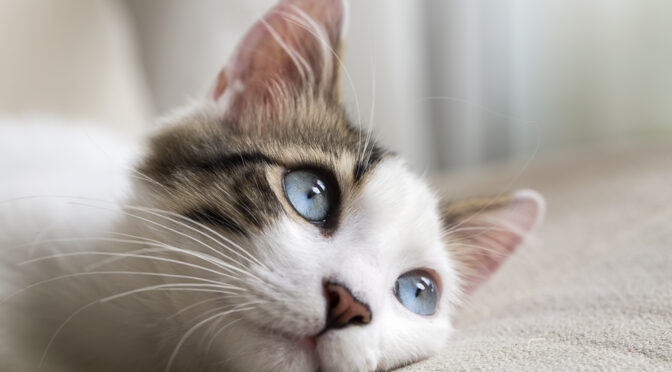The cat world is one that humans have tried to understand for as long as the cat has been domesticated. Their behaviours are typically seen as hostile compared to that of the exuberant and outwardly affectionate dog. Dogs, we know, see humans as the best thing on planet Earth, but cats are a little more resistant to that notion.
To understand how cats see us, we first have to understand how cats think, and more importantly, how cats behave in social situations. Most people assume that cats are solitary animals simply because they seem more aloof, independent than dogs. But, cats are actually not solitary at all. They’re a pack animal.
John Bradshaw, the author of Cat Sense, believes the difficulty in studying social cat behavior is that the cat’s wild ancestor, the northernmost populations of the African Wildcat, basically don’t exist anymore. African Wildcats are so thoroughly interbred with domestic cats that Bradshaw says it’s likely impossible to find a purebred African Wildcat. Feral Colonies: This is when you turn to feral cat populations.

Feral cat colonies are comprised of cats who were born and exist without direct human intervention. By comparing feral cat behaviors to that of the domestic house cat, we can kind of get an idea of how cats perceive their owners.
These feral colonies normally spring up in places where there’s enough food to support multiple cats, and safe spaces where they can rest and breed. Cats are mid level predators, meaning they both prey on animals and are preyed upon by animals.
John Bradshaw states that the main function of these groups is reproduction. Unlike wolves, cats typically do their hunting alone. However, they breed in groups and care for their young indiscriminately. A mother cat will care for pretty much anything that squeaks. In a colony a cat will catch a mouse and bring it back for whichever kitten is there. It doesn’t matter if it’s theirs or not. Cats and Kittens:
The relationship between cats and kittens is described by a set of behaviors;nursing, cleaning, weaning, as well as teaching how to hunt, poop, and cover up poop.
The relationship between adult cats is very different. Adult cats communicate almost completely through body language signals like; marking, tail movements, and physically touching or grooming each other.

However, when these movements don’t get the point across to their human counterparts housecats usually refer to vocalizations. Cats are essentially silent in their feral communities but, considered extremely vocal in their interactions with humans.
The explanation for the vocalizations is that it is an entirely learned behaviour. Meowing: Meowing is a specific response cats give when they are presented with a useful, but stupid creature like a human.
A 2003 study established that cats develop private languages with their owners, that a cat’s owner can distinguish. Basically, a cat will meow, yowl, chirp, or chuff, depending on what they want. Cats do sometimes make little vocalizations with kittens, but meowing is unknown in any other communication.
Every household cat learns individually that meowing gets a response from their owners. It doesn’t mean that the cat sees us a kitten, but is merely adapting to the strange needs of the dumb human. Hunting: Many people believe that when a cat leaves a dead animal on your doorstep it is because it believes you are too dumb or too helpless to fend for yourself. This is actually not the case.

Researchers believe the action is directly correlated with instinctual behaviors and safety. In the wild, cats do not eat their prey where they kill it. They bring it back to a place where they are safe from predators. The same is true of house cats.
They want to bring their meal back to a safe place where they can enjoy it. Most of the time, they do not eat the carcass because they realize they have much more appetizing food in the house.
Basically, your cat brings the dead animal to the house and realizes that there’s something better for him inside and simply disregards the animal. The behaviour actually has very little to do with humans at all.
How Do Cats See Humans?
Cats see humans as adult cats, but adult cats who have very different behaviours. Essentially our cats see us as giant, weird, dumb adult cats that if treated in a certain way will provide food and head scratches. A cat’s behavioural repertoire is not very sophisticated. The way cats treat animals fall into one of three categories:
– An animal the cat can eat
– An animal that can eat the cat
– An animal that fits into neither of the prior two categories that could still somehow fulfill a need like reproduction or affection.
Cats and Dogs:
The apocalyptic enemies depicted in hundreds upon hundreds of stories, movies and novellas.
If you introduce a cat to a dog in the first 12 months of its life, the cat will grow up seeing dogs as, basically, alterna-cats: A neutral animal that cannot be eaten but also will not attempt to eat the cat. So there you have it! Now that you know what’s really going on your cat’s mind, what will you do differently in the future?
Sources:
https://theawl.com/whodoesyourcatthinkyouaree73511a96d3c#.ozbq3rwb6
https://mic.com/articles/108360/sixbehaviorsthatproveyourcatactuallyhatesyou
Image Sources:
http://www.bigstockphoto.com/image97310672/stockphotomainecooncatthinking

